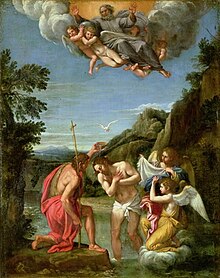
Francesco Albani's The Baptism of Christ
| Major events in Jesus' life from the Gospels |
|---|
|
The Baptism of Jesus Christ inaugurates his public ministry as an adult. It is recorded in all three synoptic gospels.[1] Matthew's infancy narrative has established Jesus as the Messiah, the Son of God, Son of David and King of the Jews. Matthew's description of John the Baptist explains that John preached repentance before the coming judgment, baptism for the forgiveness of sins, and the imminent arrival of one far greater than himself. In doing so he was preparing the way of the "Lord" and eagerly anticipating the coming after him of the "mightier" one.[2]
As an adult, Jesus comes to the Jordan River to seek his own baptism from John the Baptist. Matthew's gospel uniquely includes a conversation between Jesus and John.[Mt 3:13-17] John humbly objects to baptizing Jesus, insisting instead that Jesus baptize him. John's concern seemed to be twofold: (1) John baptized others for repentance and forgiveness of sins, something the sinless Jesus did not need; (2) John's ministry included the coming of one "mightier" than he who would bring a better baptism—not only with water but with the Holy Spirit and fire. Jesus persisted and John acceded to administer Jesus' baptism. In accepting John's baptism, Jesus is seen as identifying with and expressing his full solidarity with sinful humankind, though according to the New Testament he himself was sinless.[2][3]
Jesus inaugurated his public ministry by stepping into the place of sinners with their guilt on his shoulders and carrying it down into the depths of the Jordan. His baptism by John marked his acceptance of death for the sins of humankind; his coming up out of the water depicted his resurrection.[4]
In what may be termed an adult epiphany, Jesus' baptism by John is concluded by images of the heavens opening with the dove-like descent of the Holy Spirit. A voice from Heaven speaks in the third person singular: "This is my beloved Son in whom I am well pleased."[Mt 3:17] [Mk 1:11] [Lk 3:21-22] The voice combines key phrases from the Old Testament: "My Son" (the Davidic king as God's adopted son in Psalms 2 and Psalms 10, "beloved" (Isaac in Genesis 22), and "with whom I am well pleased" (the servant of God in Isaiah 42:1).[2]
After his baptism by John, Jesus then goes into the wilderness where the devil tempts him, and when he returns he begins his public ministry. In the Gospel of John, John the Baptist identifies Jesus as the Lamb of God[Jn 1:29] and the Spirit in the form of a dove descends on Jesus,[5] but there is no mention of Jesus' baptism.
Most Christian groups view the baptism of Jesus as an important event and a basis for the Christian rite of baptism (see also Acts 19:1-7).
In Eastern Christianity, Jesus' baptism is commemorated on 6 January, the feast of Epiphany. In the Roman Catholic Church, the Anglican Communion, and some other Western denominations, it is recalled on a day within the following week, the feast of the Baptism of the Lord. In Roman Catholicism, the baptism of Jesus is one of the Luminous Mysteries of the Rosary. It is a Trinitarian feast in the Eastern Orthodox Churches.
Location[]

The Jordan River
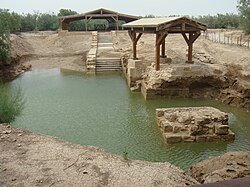
According to history and the bible, the Jordan River is the exact site of the baptism, called the Baptism site.
John the Baptist is placed by the passage in the wilderness of Judea, which is generally taken to refer to the region of Judea sloping down from the highlands to the Dead Sea, an arid area not well suited to habitation. The term normally translated as wilderness is occasionally translated as desert, although there was enough moisture to allow for pastoralism. According to Pliny this region was home to the Essenes, and John could possibly have been one of their major leaders. According to Donald Guthrie, at this time wilderness was considered much closer to God than the more corrupt cities.
According to some traditions, Jesus meets John at the Jordan River, five miles south of the Allenby Bridge, near Qasir al-Yahud on the West Bank. This location is today the site of an Eastern Orthodox monastery. The area is currently an Israeli military district closed to the public. However, during Christian holidays and on other occasions, in coordination with Israeli authorities, the site opens for public pilgrimage and baptism rituals. Other areas down the river are provided for Christian pilgrims who wish to perform baptism there themselves.
Another site with a good tradition showing early Christian activity on the Eastern bank in Jordan in Al-Maghtas (Baptism, or Immersion in Arabic), is considered by many to be the site of the baptism of Jesus following UNESCO-sponsored excavations. The location fits with John 1:28: These things took place in Bethany beyond the Jordan, where John was baptizing. As well as the evidence from archaeology and early pilgrims accounts. This site was visited by Pope John Paul II in March 2000, and in 2007 a documentary film entitled "The Baptism of Jesus Christ - Uncovering Bethany Beyond the Jordan" was made about it.
Both locations appear on the Map of Madaba:
- Western Bank as Bethabara, (House of the Ford, or of the Crossing)
- Eastern Bank as Aenon or Sapsaphas (Place of the Willows)
The baptismal scene[]
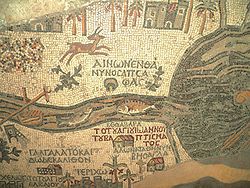
Part of the Madaba Map showing two possible Baptism locations
In Luke, Jesus is watched as one of a large crowd who had come to see John and is baptized before them, while Matthew makes no mention of anyone besides John and Jesus being at the scene. The scene opens in Luke and Matthew with John delivering a polemic apparently against the Pharisees and Sadducees who are present. Luke and Matthew then re-join the account of Mark, which does not contain the polemic, by portraying Jesus as going down to John and being baptized by him.
The polemic[]
Once John has been introduced into the narrative, both Matthew and Luke have him immediately described as meeting a group of people, and calling them a brood of vipers, urging them to repent. That Mark does not contain this lecture while the other two synoptics do has led scholars to believe that this section comes from the Q document. Luke has John addressing the people that have come to see him in general, while Matthew has him address the Pharisees and Sadducees in particular. According to several scholars, the presence of the Pharisees and Sadducees does not indicate their intent to join John's movement, but rather their wish to investigate it and decide whether it is a threat to their own power.
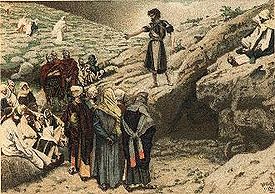
James Tissot's John and the Pharisees
A number of theories have been advanced to explain why Matthew directs John's attack to these groups while Luke focuses on the general multitude. Eduard Schweizer believes that since Matthew was writing for a more Jewish audience than Luke, Matthew did not want to offend all Jews and thus focused only on the religious authorities, who had become a direct threat to the Christianity of Matthew's time. Other scholars disagree with this view; some hold instead that Pharisees and Sadducees should be understood as a catch-all term for the Jews in general.
Brood of vipers was a common expression at the time indicating those filled with malice, which NT theologian R. T. France believes could be rooted in Jeremiah 46:22. Later in Matthew the expression is employed by Jesus himself on two occasions (Matthew 12:34 and Matthew 23:33). This insult has been borrowed by a number of other writers, including Shakespeare in Troilus and Cressida, Anthony Trollope in Barchester Towers, Somerset Maugham in Catalina, and in the title of François Mauriac's Le Nœud de vipères. In Matthew and Luke, the word used for brood implies Illegitimacy, and so scholars, such as Malina and Rohrbaugh, consider a more literal translation to be snake bastards.
Superficially, the implication of illegitimacy and the phrase don't think to yourselves "we have Abraham for a father" could be seen as an attack on the importance that Judaism placed on bloodlines. Some, such as R. T. France, do not support this interpretation, and instead see the phrase as a reference to the reliance of the Pharisees and Sadducees on their own religious authority to achieve salvation. Clearly, those having formal hierarchies in their church, particularly Roman Catholicism in regard to the Pope, do not support the interpretation of R. T. France.
John goes on to refer to future wrath, although Christians interpret this as referring to the righteous indignation of God. To avoid this wrath, John is described as stating that the fruit of repentance should be made manifest, with every tree not bearing fruit being subject to destruction. The imagery used is of God as a lumberjack cutting down trees and then burning them, much like the imagery at Isaiah 10:34 and Jeremiah 46:22, which may have been the ultimate origin of this verse. An argument for Aramaic primacy can be put forward by this since in Aramaic, the word for a tree root is ikkar, while cutting down is kar, hence in Aramaic the description is an example of punning. Scholars of the eschatological school[6] believe that this verse originally referred to an imminent last judgment which, when it failed to occur, was re-interpreted by later Christianity as referring to individual damnation.
In Luke, the crowd react favourably to John's speech, but Matthew neglects to mention the reaction of the crowd.
This passage has become a source of much dispute over soteriology. While the passage could be read as indicating that good works are merely the outgrowth of internal repentance just as good fruit are the product of a healthy tree, it could also be more simply be regarded as indicating that good works are repentance. This verse thus became a part of the larger debate over the doctrine held by Protestants about justification by faith. The Augsburg Confession, for instance, states that "it is taught among us that such faith should produce good fruits and good works and that we must do all such good works as God has commanded, but we should do them for God’s sake and not place our trust in them as if thereby to merit favour before God."
Holy Spirit's descent[]
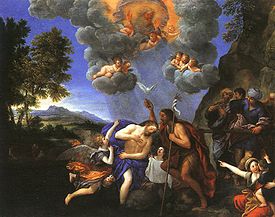
Francesco Albani's The Baptism of Christ
While Luke is explicit about the Spirit of God descending in the shape of a dove, the wording of Matthew is vague enough that it could be interpreted only to suggest that the descent was in the style of a dove. There was a wide array of symbolism attached to doves at the time these passages were written. While Howard Clarke[7] believes the symbolism pointed to Noah sending out a dove to search out new land and hence is a symbol of rebirth, Albright and Mann[8] note that in Hosea, the dove is a symbol for the nation of Israel. Whatever the original intent of the Synoptic Gospels, the dove imagery has become a well known symbol for the Holy Spirit in Christian art.
John the Baptist in the narrative[]
Persona[]

Hieronymus Bosch's St. John the Baptist
The narrative begins with a description of a man that Matthew names John the Baptist, Luke names John the son of Zacharias, and many manuscripts of Mark refer to as John the baptizer. On this latter name, Anabaptists insist on the more emphatic translation John the Immerser. John's title reflects his practice of baptizing people in the Jordan.
John is described as having sparse food and uncomfortable clothing, including the wearing of hairshirts. The description of John the Baptist has played an important role in the development of Christian monasticism, with John viewed as a model ascetic. However, Calvin wholly rejected this interpretation, seeing this description simply as an accurate portrait of anyone that was forced to live in the wilderness, and instead seeing John's holiness and popularity not because of his asceticism but despite it. Albright and Mann[8] state that the description of John the Baptist's clothing is clearly meant to echo the similar description of Elijah in Kings.
John the Baptist's diet, which the Bible indicates was locusts and honey, has been the centre of much discussion. For many years it was traditional to interpret locust not as referring to the insect, but rather to the seed pods of the carob tree. Albright and Mann[8] believe that this attempt to portray John the Baptist as eating seed pods was a combination of concern for having such a revered figure eating insects, and also a belief that a true ascetic should be completely vegetarian. In Greek the two words are very similar. Most scholars today conclude that this passage is referring to the insects, particularly since the other 22 times the word is used in the Bible it quite clearly refers to insects. Locusts are still commonly eaten in Arabia, and like many insects are quite nutritious. While most insects were considered unclean, Leviticus permits locusts. What is meant by "honey" is also a subject of some dispute. Aside from the obvious product of bees, scholars such as Jones[9] believe that it refers to gum from the tamarisk tree, a tasteless but nutritional type of liquid.
Message[]

John the Baptist in the Wilderness by Geertgen tot Sint Jans
After announcing John's existence, the Gospel of Matthew immediately goes on to portray him as delivering the message Repent, for the kingdom of heaven is nigh. In both Luke and Mark, however, the message is absent. Clarke[7] notes that this is the first of twenty-nine references to the Kingdom of Heaven in the Gospel of Matthew. Luke and Mark tend to prefer the term "kingdom of God." That Matthew uses the word heaven is often seen as a reflection of the sensibilities of the Jewish audience this gospel was directed to, in this case Matthew trying to avoid using the word God. Most scholars believe the two phrases are theologically identical because of the large number of parallel passages in Matthew and Luke in which Matthew uses "heaven" and Luke uses "God." Robert Foster rejects this view, arguing that Matthew does use the phrase "Kingdom of God" in places. He asserts that the Kingdom of God represents the earthly domain that Jesus' opponents such as Pharisees thought they resided in, while the Kingdom of Heaven represents the truer spiritual domain of Jesus and his disciples.
Some scholars[who?] believe that when it was written this phrase was intended to be eschatological with the Kingdom of Heaven referring to the end times. According to this theory, when the last judgment failed to occur, Christian writers gradually redefined the term to refer to a spiritual state within, or worked to justify a much delayed end time. This passage, they say, presented a difficulty in this later endeavour as the phrase translated as "at hand" or "is near" both refer to an imminent event. Albright and Mann[8] suggest that a better translation would be, The kingdom is fast approaching. France sees it as even more immediate suggesting that the phrase should be read as referring to "a state of affairs that is already beginning and demands immediate action."; i.e., "The kingdom of God is here."
Others such as O. Cullmann interpret John (and Jesus—Mark 1:15)[10] to refer to an inaugurated kingdom; one which is present now but is not yet come in all of its fullness, i.e., the kingdom being here (because the king has arrived), but without being in the fullness of its glory.
The word translated as repent (metanoo) is translated by R.T. France as "return to God." Albright and Mann[8] state that at the time a general repentance was seen as necessary before the arrival of the messiah; evidence from Qumran seems to substantiate this claim.[11] Clarke[7] notes that in the Vulgate of St. Jerome the word is translated, both here and in Matthew 4:17, as paenitentiam agite, which he interprets not as "repent", but as "be penitent", in spite of the use of paenitentiam agere in the sense of "repent" by the late Classical Latin writers Sallust, Quintilian, Pliny the Younger and Seneca.[12] Clarke[7] claims that Jerome's translation played a central role in the development of the Catholic doctrine of penance. With the increased knowledge of Greek in the Renaissance this translation began to be criticized, with Lorenzo Valla first pointing out the supposed error. Erasmus' 1516 translation and commentary (in Latin) became the first to use "repentance" (in Latin, paenitentia?) rather than "penitence" (in Latin, paenitentia?).
John's purpose according to the synoptic gospels[]

A woodcut from the 1516 Das Plenarium oder Ewangely buoch showing John the Baptist preaching
In all three of the synoptic gospels, John the Baptist is described as completing a prophecy made by Isaiah; as the individual who would make straight the paths of him. The quote, coming from Isaiah 40:3, refers in its original context to making straight the paths of God, and specifically in reference to later escape from the Babylonian Captivity. Rather than the Masoretic text, the quote uses the wording of the Septuagint, as is usual for New Testament quotations of the Old Testament.
The importance of John[]

An illustration of John the Baptist preaching about the Kingdom of Heaven, from the 1875 Young People's Illustrated Bible History
Matthew and Luke describe Jews coming from Jerusalem, all of Judea, and the areas around the Jordan River to hear John the Baptist preach. This description is considered quite historically credible as it is backed up by Josephus. In his Antiquities of the Jews he says of John the Baptist that the others came in crowds about him, for they were very greatly moved by hearing his words.[13] At the time Josephus was writing, around 97 AD, John the Baptist seems to have been an exceptionally more significant figure than Jesus—while John is frequently mentioned, hardly anyone appears to have mentioned Jesus at all, in all of Josephus' writing, there are only two very short passages which could possibly refer to Jesus, and these are heavily disputed with most scholars seeing them as forgeries.
Unlike Luke and Mark, Matthew has John being hesitant about baptizing Jesus, with John stating that Jesus should be the one baptizing him, though it doesn't state exactly why. The Gospel of the Nazoraeans, a text which has very strong similarities to Matthew, adds a clarification to this story, stating that it was because of Jesus' sinlessness that John felt he was the one who should be baptized. In the environment in which the author of Matthew is presumed to have been writing, there would still have been many followers of John the Baptist who felt he was equal to or superior to Jesus. And while the followers of John are often presented as becoming followers of Jesus, the ancient Mandaean religion, which survives much reduced to the present day, claims to originate in a direct line from the followers of John, without being tainted by following Jesus.
Baptism and John[]

Fra Angelico's Baptism of Christ
The origins of John's baptism ritual are much discussed amongst scholars. While various forms of baptism were practiced throughout the Jewish world at this time, only those of John the Baptist and Qumran are associated with an eschatological purpose, leading many scholars to connect John to the group that wrote the Dead Sea Scrolls. In Qumran, however, baptism was a regular ritual for individuals rather than the one-time event that the synoptics present it as. Obviously that the synoptics describe John as baptizing people in the once-off form could simply be due to them putting a spin on John's historic behaviour due to being motivated to present him in accordance with Christian theology.
John the Baptist is described by Mark, Luke, and Matthew as referring to a successor, who will baptize with the Holy spirit and with fire. While John is presented as describing this successor as coming after him, the word usually translated after does not have a chronological meaning, but means instead after in sequence. It is often used to indicate that the one following is a disciple of the previous one (e.g., Matthew 4:19, but it also can simply mean behind[Mt 16:23] or after.[Lk 19:14]) At the time, the disciple of a rabbi would be expected to perform menial chores, but as sandals were considered unclean, a view still persisting in the Middle East today, not even a disciple would deal with them, only the lowest slave. Thus when the text has John presenting himself as not worthy to carry/untie the sandals of his successor, he is presenting himself as extremely lowly in comparison.
Fire was often a symbol of wrath, and so linking the Holy Spirit with it superficially appears to clash with portrayals of this Spirit elsewhere in the New Testament as a gentle thing. Some translations avoid using the word fire due to this, but when the Dead Sea Scrolls were discovered, it appeared that several of its texts make the connection between Holy Spirit and wrath, and so most scholars now see the wording here as original, and the other portrayals as misinterpreted. See also Acts2 {{{2}}}.
Non-canonical and heterodox accounts[]
Jesus' baptism figures into non-canonical accounts and into some beliefs considered heretical by orthodox Christianity.
Adoptionism[]
Adoptionism, the belief that the man Jesus was adopted as the Son of God, was one of two popular Christologies in the 2nd century. One type of adoptionism, such as that held by the Jewish Christian Ebionites, held that Jesus became the Son of God at his baptism. The other type held that Jesus became the Son of God at his resurrection.
Cerinthus[]
The first-century proto-Gnostic Cerinthus taught that the Christ (a spirit) came to the man Jesus at his baptism, remained distinct from him (while guiding and teaching him), and then left him at the crucifixion.
Historicity[]

Stained glass window in Brown Memorial Presbyterian Church, depicting Jesus' Baptism. The window is by Louis Comfort Tiffany.
Stephen L. Harris[14] has stated that historians know little about the historical Jesus, but that they generally agree that he was baptized by John the Baptist. Scholars who follow the historical-critical method find this event credible because it satisfies the criteria of multiple attestation and dissimilarity, that is, multiple sources attest to its happening, and it is not the sort of detail that early Christians would make up. Like the crucifixion, it meets what they call the criterion of multiple attestation and the criterion of embarrassment. Even scholars who credit very little of the Gospel narratives, such as Paula Fredriksen, affirm the historicity of Jesus' baptism.
- Multiple Attestation: Three canonical Gospels and various non-canonical sources agree that John baptized Jesus. The fourth canonical Gospel and other canonical and non-canonical sources also attest to John's ministry of baptism. Josephus, for example, recounts John's ministry. Thus Jesus' baptism meets this criterion, while less well-attested elements of the Gospels, such as the Massacre of the Innocents, do not.
- Embarrassment: Scholars of this method give special credence to Gospel accounts that are "dissimilar" to the image that early Christians generally portray of Jesus. This why some refer to this criterion as that of "dissimilarity". Since Jesus was regarded as without sin (and not in need of baptism) and to be greater than John, early Christians would have had no motive to invent such a scene, which would have been an embarrassment to them. The last-written Gospel does not mention Jesus' baptism. Thus Jesus' baptism meets this criterion, while more glorifying elements of the Gospel narratives, such as his virgin birth, do not.
Others disagree. Skeptical science writer Frank R. Zindler argues that the references to John in Josephus are a later addition whence no external corroboration for the figure of John exists. Parallels between the figure of John and worship of Oannes of Babylonian mythology have been noted by Joseph Campbell and others casting doubt on the historicity of John.
The Baptism of Jesus in the Gospel of the Hebrews[]
The Logia of Yeshua, by Guy Davenport and Benjamin Urrutia, footnote 2, pages 50–51, comments on the Gospel of the Hebrews, a non-canonical gospel extant only in fragments quoted by other writers, in which, according to Jerome, Jesus' family suggested that he be baptized: "The mother of the Lord and his brothers said to him, 'John the Baptist baptizes for the forgiveness of sins; let us go and be baptized by him.' But he said to them, 'In what way have I sinned that I should go and be baptized by him? Unless, perhaps, what I have just said is a sin of ignorance.'",[15] The commentary says: "Many early Christians seem to have been embarrassed by the fact that Yeshua ( Jesus ) was baptized by Yohannan ( John the Baptist ). The Gospel of John neglects to mention this baptism ... The Synoptics try several ploys. Yohannan says he should be baptized by Yeshua, and not the other way around. Misleading hints are given that someone else, not Yohannan, performed the Immersion. Scholars in general (except for Robert Graves and Joshua Podro ...) take for granted that the story of Mariam [ Mary ] and Yeshua's brothers persuading a reluctant Yeshua to be baptized belongs to the same category ... [but] this story would add to the embarrassment ... The idea for this very important step in Yeshua's life comes from somebody else ... Yeshua changes his mind. He admits he may be guilty of a sin after all."
Urrutia and Davenport also point out that the Hebrew Gospel was produced by a community that included the family of Jesus, so it is most likely to contain authentic family traditions.
References[]
Some or all of this article is forked from Wikipedia. The original article was at Baptism of Jesus. The list of authors can be seen in the page history.
- ↑ Matthew 3:13-17; Mark 1:9-11; Luke 3:21-22.
- ↑ 2.0 2.1 2.2 Harrington, Daniel J., SJ. "Jesus Goes Public." America, Jan. 7-14, 2008, pp.38ff
- ↑ 2 Cor. 5:21; Hebrews 4:15; 1 Peter 3:18
- ↑ Pope Benedict XVI. Jesus of Nazareth. Doubleday Religion, 2007. ISBN 0385523416
- ↑ In John 1:32 John says: "I saw the Spirit descend as a dove from heaven, and it remained on him," namely on Jesus. This echoes closely the words by which the Synoptic Gospels report the actual baptism of Jesus: "When Jesus was baptized, he went up immediately from the water, and behold, the heavens were opened and he saw the Spirit of God descending like a dove, and alighting on him" (Matthew 3:16; cf. Mark 1:10 and Luke 3:20).
- ↑ http://www.westarinstitute.org/Polebridge/Title/5Gospels/Seven_Pillars/seven_pillars.html
- ↑ 7.0 7.1 7.2 7.3 Clarke, Howard W. The Gospel of Matthew and its Readers: A Historical Introduction to the First Gospel. Bloomington: Indiana University Press, 2003.
- ↑ 8.0 8.1 8.2 8.3 8.4 Albright, W.F. and C.S. Mann. "Matthew." The Anchor Bible Series. New York: Doubleday & Company, 1971. Cite error: Invalid
<ref>tag; name "A&M" defined multiple times with different content - ↑ Jones, Alexander. The Gospel According to St. Matthew. London: Geoffrey Chapman, 1965
- ↑ Mark 1:15
- ↑ John the Baptist
- ↑ paenĭtentĭa in Charlton T. Lewis, Charles Short, A Latin Dictionary
- ↑ http://www.religiousstudies.uncc.edu/jdtabor/john.html
- ↑ Harris, Stephen L. Understanding the Bible. Palo Alto: Mayfield. 1985.
- ↑ The Gospel of Hebrews from Throckmorton and Barnstone
Books[]
- Guy Davenport, and Benjamin Urrutia, The Logia of Yeshua. Washington, DC: Counterpoint, 1996.
- France, R.T. The Gospel According to Matthew: an Introduction and Commentary. Leicester: Inter-Varsity, 1985.
- Gundry, Robert H. Matthew a Commentary on his Literary and Theological Art. Grand Rapids: William B. Eerdmans Publishing Company, 1982.
- Guthrie, Donald. The New Bible Commentary. Grand Rapids: Eerdmans, 1970.
- Hill, David. The Gospel of Matthew. Grand Rapids: Eerdmans, 1981
- Hurtago, Larry W. "Generation of Vipers." A Dictionary of Biblical Tradition in English Literature. David Lyle Jeffrey, general editor. Grand Rapids: W.B. Eerdmans, 1992.
- Jones, Alexander. The Gospel According to St. Matthew. London: Geoffrey Chapman, 1965.
- Malina, Bruce J. and Richard L. Rohrbaugh. Social-Science Commentary on the Synoptic Gospels. Minneapolis: Fortress Press, 2003.
- Murray, John. Christian Baptism. Phillipsburg, NJ: Presbyterian and Reformed Pub., 1962.
- Schweizer, Eduard. The Good News According to Matthew. Atlanta: John Knox Press, 1975
- Pastor Jong Are You Truly Born Again of Water and the Spirit. Korea Hephziba Publishing